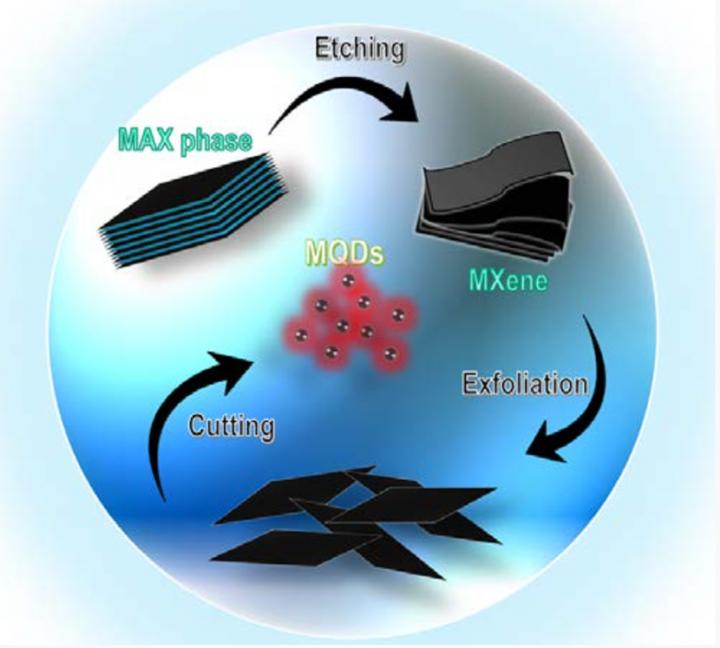
Credit: Opto-Electronic Advances
In a new publication from Opto-Electronic Advances; DOI https:/
MXenes have found wide-ranging applications in energy storage devices, sensors, catalysis, etc. owing to their high electronic conductivity and wide range of optical absorption. However, the absence of semiconducting MXenes has limited their applications related to light emission.
Extensively reviewing current relevant research, the authors summarise recent advances in MXene quantum dot (MQD) research on the synthesis, optical properties and applications of MQDs as light emitting quantum materials. Research has shown that quantum dots (QDs) derived from MXene (MQDs) not only retain the properties of the parent MXene but also demonstrate significant improvement on light emission and quantum yield.
The authors provide an overview of light emitting MQDs and their synthesis methods, optical properties, and applications in various optical, sensory, and imaging devices. Future prospects for light emitting MQDs are also discussed to provide insight to help further advance research.
Article reference: Sharbirin AS, Akhtar S, Kim JY. Light-emitting MXene quantum dots. Opto-Electron Adv 4, 200077 (2021) . doi: 10.29026/oea.2021.200077
Keywords: MXene, quantum dots, light emission, MAX phase, 2D materials
Professor Kim’s research group carries out cutting-edge research on 2D materials focusing on their light emission properties. From 2014, the group has presented pioneering results on spatially and spectrally identifying the exciton complexes of 2D-transition metal dichalcogenides such as MoS2 and WS2. Using a variety of chemical or physical treatments or specific device configurations the group has demonstrated how to engineer or improve the emission characteristics of these 2D direct bandgap semiconductors. By recently extending the scope of the study on 2D materials into MXenes, the research group is now exploring non-toxic, bio-compatible and high-efficiency light emission by MQDs.
###
Opto-Electronic Advances (OEA) is a high-quality, open access, peer reviewed research journal that is published by The Institute of Optics and Electronics, Chinese Academy of Sciences. OEA provides a platform for researchers, academicians, professionals, practitioners, and students to impart and share knowledge in the form of high quality empirical and theoretical research papers covering the topics of optics, photonics and optoelectronics.
Since its launch in March 2018, OEA has expanded into a monthly publication schedule. From 2020 OEA is indexed by Science Citation Index Expanded (SCIE) and SCOPUS. From the current Web of Science (WoS) data, OEA expects that the June 2021 Journal Citation Report (JCR) should show that the journal has an Impact Factor of about 10.
More information: http://www.
Editorial Board: http://www.
All issues available in the online archive (http://www.
Submissions to OEA may be made using ScholarOne (https:/
ISSN: 2096-4579
CN: 51-1781/TN
Contact Us: [email protected]
Twitter: @OptoElectronAdv
Media Contact
Morgan lyons
[email protected]
Related Journal Article
http://dx.




